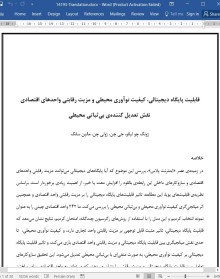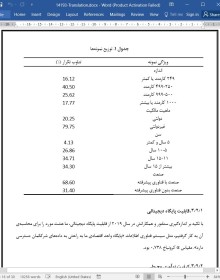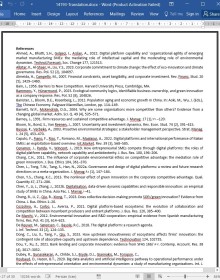
دانلود مقاله قابلیت پایگاه دیجیتالی، کیفیت نوآوری محیطی و مزیت رقابتی واحدهای اقتصادی
خلاصه
در زمینهی عصر «اینترنت پلاس»، بررسی این موضوع که آیا پایگاههای دیجیتالی میتوانند مزیت رقابتی واحدهای اقتصادی و سازوکارهای داخلی این رابطهی بالقوه را افزایش دهند یا خیر، از اهمیت زیادی برخوردار است. براساس نظریهی قابلیتهای پویا، این مطالعه، تاثیر قابلیتهای پایگاه دیجیتالی را بر مزیت رقابتی واحد اقتصادی و همچنین اثر میانجیگری کیفیت نوآوری محیطی و بیثباتی محیطی را بررسی میکند. ما 242 واحد اقتصادی چینی را به عنوان نمونه انتخاب کردیم و این مدل را با استفاده از روشهای رگرسیون چندگانه، امتحان کردیم. نتایج نشان میدهد که قابلیت پایگاه دیجیتالی، تاثیر مثبت قابل توجهی بر مزیت رقابتی واحد تجاری دارد، و کیفیت نوآوری محیطی، تا حدی نقش میانجیگری بین قابلیت پایگاه دیجیتالی و مزیت رقابتی واحد اقتصادی بازی میکند، و تاثیر قابلیت پایگاه دیجیتالی بر کیفیت نوآوری محیطی، به صورت منفیای با بیثباتی محیطی تعدیل میشود. این تحقیق سازوکارهای تعامل بین قابلیت پایگاه دیجیتالی و مزیت رقابتی را نشان میدهد، که میتواند به واحد اقتصادی برای ساختن پایگاههای دیجیتالی کمک کند و کیفیت نوآوری محیطی و مزیت رقابتیشان را بهبود بخشد.
1. مقدمه
با سرعت گرفتن صنعتی شدن و زیاد شدن تناقضهای عملی، مثل پیرشدن جمعیت، آگاهی محیطی و بیثباتی محیط اقتصادی، مزیتهای رقابتی ایجاد شده در واحدهای تولیدی به واسطهی نیروی کار ارزان و مدلهای تولید گسترده، به تدریج از بین میرود (بنیستر و همکارانش، 2012، تان و همکارانش، 2022، ژائو و همکارانش 2022). نیاز است که هم دولت و هم متخصصان، این سوال را فوراً حل کنند که چگونه در حالی که هستهی اصلی رقابت به یک چالش برای واحدهای اقتصادی تبدیل شده است، به توسعهای با کیفیت بالا دست پیدا کنیم. بنابراین متخصصان به تدریج کاربرد فناوریهای نوظهور مثل پایگاههای دیجیتالی، تولید و بهرهبرداری پایدار شامل نوآوری محیطی (چنگ و همکارانش، 2023، کوان و همکارانش، 2023) و تواناییهای بالقوهی متعدد چنین رویکردهای در هم گسیختهای را به عنوان ادغام سیستمهای بوم شناسی بالادست و پایین دستی در زنجیرهی صنعتی در ساختار اصلی مزیتهای رقابتی به تدریج مورد بررسی قرار دادهاند (دونگ و همکارانش 2023). در این زمینه روند تحول دیجیتالی و افزایش واحدهای اقتصادی، به طور موثری با فناوری دیجیتال ادغام شدهاند (سیا و همکارانش 2021). اقتصاد دیجیتال به تدریج به یک نیروی انگیزشی پس از اقتصادهای کشاورزی و صنعتی برای توسعهی اقتصاد جهانی تبدیل شده است، و در حال آوردن فرصتهای جدیدی برای افزایش رقابت در واحدهای تولیدی هستند (کازولینو و همکارانش، 2021، سرور و همکارانش، 2023، تیان و همکارانش 2023).
به عنوان آورندهی اصلی و شکل سازمانی اقتصاد دیجیتال، پایگاههای دیجیتالی بر مبنای اشتراک چند عاملی و تعامل متقابل مرزی، عملکردهایی مقیاسپذیر، توسعهپذیر و تکمیلی دارند (تیوانا، 2014، کارهو و همکارانش، 2018) ، راههای جدیدی به جهت ایجاد ارزش برای سهامداران فراهم میآورند (کمال و همکارانش، 2022) و به واحدهای اقتصادی کمک میکنند که منابع بارزش خارجی را به دست آورند (وانگ و همکارانش، 2023) تا به نوآوری پایداری (چن و همکارانش 2022) دست یابند و مزیت رقابتی جدیدی را ایجاد کنند (سنامور و همکارانش، 2019، احمد و همکارانش، 2022). قابلیت پایگاه دیجیتالی میتواند به عنوان یک توانایی سازمان برای استفاده از پیشرفتهترین ابزارها و فناوریهای دیجیتال به عنوان ابزارهای رقابتی آن بر مبنای پایگاههای دیجیتالیش تعریف شود، که این امر به عنوان یک قابلیت پویای مرتبهی بالاتری در نظر گرفته میشود (سنامور و همکارانش، 2019) که به گونهای موثر به واحد اقتصادی کمک میکند تا منابع را هماهنگ کند و به عملکرد دلخواه دست یابد (کریم و والتر، 2015).
5.4. دستورالعملها و محدودیتها برای تحقیقات آتی
محدودیتهای زیر بهتر است که اذعان داشته شوند. در ابتدا، ارتباط بین قابلیت پایگاه دیجیتالی و مزیت رقابتی واحد اقتصادی، که به ناچار تحت تاثیر عوامل داخلی و خارجی قرار میگیرند. ما فقط عدم قطعیتهای محیطی را به عنوان متغیر تعدیلکننده انتخاب کردیم. بنابراین تحقیقات آینده میتوانند متغیرهای تعدیلکنندهی بیشتری را بگنجانند تا بتوانند اثرات مشترکشان را بررسی کنند. دوم اینکه، ما واحدهای اقتصادی در حوزهی تولید را به عنوان نمونههای تحقیق انتخاب کردیم و تمام صنایع را پوشش ندادیم. در نتیجه نتایج را ممکن است نتوان به تمام واحدهای اقتصادی تعمیم داد. تحقیقات بعدی بهتر است که نمونهها را گسترش دهند و تفاوتهای نتایج را بین صنایع مختلف با هم مقایسه کنند. سوم اینکه، از منظر نوآوری محیطی، این مطالعه به طور عمده فقط مسیر داخلی تاثیر قابلیت پایگاه دیجیتالی بر مزیت رقابتی واحد اقتصادی را تجزیه و تحلیل میکند، در حالیکه مسیرهای متعدد دیگری میتواند مورد بررسی قرار بگیرد. تحقیقات بعدی میتواند مسیرهای داخلی بیشتر و همچنین اهمیتشان را بررسی کند.
Abstract
In the context of the “Internet plus” era, exploring whether digital platforms can enhance firms' competitive advantage, and the internal mechanism of this potential relationship, is of great significance. Based on the theory of dynamic capabilities, this study examines the impact of digital platform's capability on firms' competitive advantage, as well as the mediating effect of environmental innovation quality and the moderating effect of environmental uncertainty. We selected 242 firms in the Chinese manufacturing industry as the sample and tested the model using multiple regression methods. The results show that digital platform capability has a significant positive impact on firms' competitive advantage, environmental innovation quality plays a partial mediating role between digital platform capability and firms' competitive advantage, and the effect of digital platform capability on firms' environmental innovation quality is negatively moderated by environmental uncertainty. The research reveals the mechanism of interaction between digital platform capability and competitive advantage, which can aid firms in building digital platforms, and improve the quality of their environmental innovation and their competitive advantage.
1. Introduction
With the acceleration of industrialization and the intensification of practical contradictions, such as aging populations, environmental awareness, and economic environment uncertainty, the competitive advantages of manufacturing firms generated by low-cost labor and extensive production models are gradually dissipating (Banister et al., 2012; Tan et al., 2022; Zhao et al., 2022). The question of how to achieve high-quality development while maintaining core competitiveness has become a key challenge for manufacturing firms, which both governments and scholars urgently need to solve. Scholars have thus gradually explored the application of emerging technologies, such as digital platforms (Sarwar et al., 2023; Wang et al., 2023b), sustainable production and operation, including environmental innovation (Cheng et al., 2023; Quan et al., 2023), and the enormous potential of such disruptive approaches as the integration of firms’ upstream and downstream ecosystem systems in the industrial chain in building core competitive advantages (Dong et al., 2023). In the context of firms’ digital transformation trend, and increasing number of firms have effectively integrated digital technology (Sia et al., 2021). The digital economy has gradually become the main driving force for the development of the global economy, following the agricultural and industrial economies, bringing new opportunities to enhance the competitiveness of manufacturing firms (Cozzolino et al., 2021; Sarwar et al., 2023; Tian et al., 2023).
As the main carrier and organizational form of the digital economy, digital platforms, based on multi-agent participation and crossboundary interaction, have scalability, extensibility, and complementary functions (Tiwana, 2014; Karhu et al., 2018), provide new ways to create value for stakeholders (Kamal et al., 2022), and help firms obtain valuable external resources (Wang et al., 2023b) to achieve sustainable innovation (Chen et al., 2022a) and establish a core competitive advantage (Cenamor et al., 2019; Ahmed et al., 2022). Digital platform capability can be defined as an organization’s ability to use the most advanced digital tools and technologies as its competitive instruments based on its digital platforms; it is considered a higher-order dynamic capability (Cenamor et al., 2019), which helps the firm effectively coordinate resources and achieve optimal operation (Karimi and Walter, 2015). It is the result of a firm’s effort to enrich its strategies in response to competitive pressures (Li et al., 2016). Realizing the enormous potential of digital platforms for firms’ growth, scholars have conducted preliminary explorations on the consequences of their capabilities, such as innovation (Wang et al., 2022, 2023b; Wang et al., 2023b) and performance (Cenamor et al., 2019; Sarwar et al., 2023), and have further explored their internal mechanisms, including dynamic capabilities (Cenamor et al., 2019) and intellectual capital (Ahmed et al., 2022). Nonetheless, some areas still require further exploration.
5.4. Limitations and directions for future research
The following limitations should be acknowledged. First, the relationship between digital platform capability and firms’ competitive advantage is inevitably influenced by external and internal factors. We only selected environmental uncertainty as the moderating variable. Therefore, future research can incorporate more moderating variables so as to explore their joint effects. Second, we selected firms in the manufacturing industry as the research sample, but did not cover all industries. Consequently, the results may not be generalizable to all firms. Future research should expand the sample and compare the differences in results between different industries. Third, from the perspective of environmental innovation, this study mainly analyzed the internal path of the impact of digital platform capability on firms’ competitive advantage; however, numerous other paths could be investigated. Future research could explore more internal pathways, as well as their importance.
H1. Digital platform capability has a positive impact on firms’ competitive advantage.
H2. Digital platform capability has a positive impact on the quality of firms’ environmental innovation.
H3. Environmental innovation quality has a positive impact on firms’ competitive advantage.
H4. The quality of environmental innovation plays a mediating role between digital platform capability and firms’ competitive advantage.
H5. The relationship between digital platform capability and the quality of firms’ environmental innovation is negatively moderated by environmental uncertainty.
H1. قابلیت پایگاه دیجیتالی، تاثیر مثبتی بر مزیت رقابتی واحد اقتصادی دارد.
H2. بر این اساس، قابلیت پایگاه دیجیتالی تاثیر مثبتی بر کیفیت نوآوری محیطی واحد اقتصادی دارد.
H3. کیفیت نوآوری محیطی تاثیر مثبتی بر روی مزیت رقابتی واحد اقتصادی دارد.
H4. کیفیت نوآوری محیطی، نقشی واسط بین قابلیت پایگاه دیجیتالی و مزیت رقابتی واحد اقتصادی ایفا میکند.
H5. ارتباط میان قابلیت پایگاه دیجیتالی و کیفیت نوآوری محیطی به صورتی منفی با عدم قطعیت محیطی تعدیل میشود.
Size
Age
Ownership
Industry category
Digital platform capability
Environmental uncertainty
Environmental innovation quality
Competitive advantage
خلاصه
1. مقدمه
2. سابقهی نظری و فرضیهها
2.1. تاثیر قابلیت پایگاه دیجیتالی بر مزیت رقابتی واحد اقتصادی
2.2. تاثیر قابلیت پایگاه دیجیتالی بر کیفیت نوآوری محیطی
2.3. تاثیر کیفیت نوآوری محیطی بر مزیت رقابتی واحدهای اقتصادی
2.4. نقش واسط کیفیت نوآوری محیطی
2.5. نقش تعدیل کنندهی عدم قطعیت محیطی
3. هنجارها
3.1. منابع اطلاعاتی
3.2. متغیر اندازهگیری
3.2.1. قابلیت پایگاه دیجیتالی
3.2.2. کیفیت نوآوری محیطی
3.2.3. عدم قطعیت محیطی
3.2.4. مزیت رقابتی
3.2.5. متغیرهای کنترل
4. نتایج
4.1. تحلیل توصیفی
4.2. آزمون فرضیه
5. نتیجه و تصمیمگیری
5.1. نتیجهگیری
5.2. مفاهیم نظری
5.3. مفاهیم مدیریتی
5.4. دستورالعملها و محدودیتها برای تحقیقات آتی
انطباق با استانداردهای اخلاقی
تقدیر و تشکر
منابع
Abstract
1. Introduction
2. Theoretical background and hypotheses
2.1. The impact of digital platform capability on firms’ competitive advantage
2.2. The impact of digital platform capability on firms’ environmental innovation quality
2.3. The impact of environmental innovation quality on firms’ competitive advantage
2.4. The mediating role of environmental innovation quality
2.5. The moderating role of environmental uncertainty
3. Methods
3.1. Data sources
3.2. Variable measurement
3.2.1. Digital platform capability
3.2.2. Environmental innovation quality
3.2.3. Environmental uncertainty
3.2.4. Competitive advantage
3.2.5. Control variables
4. Results
4.1. Descriptive analysis
4.2. Hypothesis testing
5. Conclusion and discussion
5.1. Conclusion
5.2. Theoretical implications
5.3. Managerial implications
5.4. Limitations and directions for future research
Compliance with ethical standards
Acknowledgements
References
این محصول شامل پاورپوینت ترجمه نیز می باشد که پس از خرید قابل دانلود می باشد. پاورپوینت این مقاله حاوی 21 اسلاید و 5 فصل است. در صورت نیاز به ارائه مقاله در کنفرانس یا سمینار می توان از این فایل پاورپوینت استفاده کرد.
در این محصول، به همراه ترجمه کامل متن، یک فایل ورد ترجمه خلاصه نیز ارائه شده است. متن فارسی این مقاله در 9 صفحه (2100 کلمه) خلاصه شده و در داخل بسته قرار گرفته است.
علاوه بر ترجمه مقاله، یک فایل ورد نیز به این محصول اضافه شده است که در آن متن به صورت یک پاراگراف انگلیسی و یک پاراگراف فارسی درج شده است که باعث می شود به راحتی قادر به تشخیص ترجمه هر بخش از مقاله و مطالعه آن باشید. این فایل برای یادگیری و مطالعه همزمان متن انگلیسی و فارسی بسیار مفید می باشد.
بخش مهم دیگری از این محصول لغت نامه یا اصطلاحات تخصصی می باشد که در آن تعداد 50 عبارت و اصطلاح تخصصی استفاده شده در این مقاله در یک فایل اکسل جمع آوری شده است. در این فایل اصطلاحات انگلیسی (تک کلمه ای یا چند کلمه ای) در یک ستون و ترجمه آنها در ستون دیگر درج شده است که در صورت نیاز می توان به راحتی از این عبارات استفاده کرد.
- ترجمه فارسی مقاله با فرمت ورد (word) با قابلیت ویرایش و pdf بدون آرم سایت ای ترجمه
- پاورپوینت فارسی با فرمت pptx
- خلاصه فارسی با فرمت ورد (word)
- متن پاراگراف به پاراگراف انگلیسی و فارسی با فرمت ورد (word)
- اصطلاحات تخصصی با فرمت اکسل



